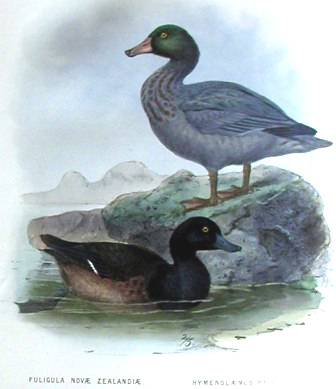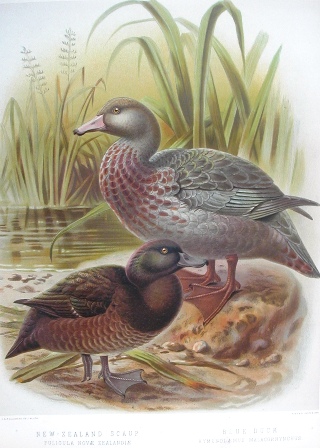
There are two birds the local branch of the ornithological society take a proprietary interest in, Tuturiwhatu, the New Zealand dotterel and Whio, the blue duck, both being the more precious for being so highly endangered. Monitoring the New Zealand or red breasted dotterel is a relatively easy trip to the local sand spits but the blue duck is another matter, involving a long tortuous drive up to Toatoa and to the western edge of the Raukumara Forest Park.
It is a trip we make at least once a year through the depressing landscape of the Toatoa Valley, scarred by erosion and the misfortunes of very marginal farming over a hundred and fifty years. There is much of this sort of land throughout the country that reveals the sorry history of politicians promoting regional development in order to get rural votes. It has left us a legacy of huge tracks of pinus radiata, much of which will probably never be harvested, and the brush tailed possum. Would that they had given the same financial incentives to plant Rimu or Totara.
But there is some compensation along the way, Miromiro, the tomtit, Koekoea, the long tailed cuckoo, and Pihoihoi, the pipit, and even the occasional Weka, the Toatoa being the last refuge of the North Island subspecies. The only introduced birds that seem to penetrate here are the chaffinch and magpie and although it would seem to be falcon country, it is the harrier hawk which prevails.
We always get there around midday, which is not the best time to see blue duck as they are active in the early morning and evening but then I think we are only there to let them know we care, that someone is looking out for them.
As we scan the banks of the streams, it is difficult to see them against the blue grey rock, perfectly camouflaged as they rest up through the day. A hundred years ago, Buller said they were so tame that he could almost catch them by hand but now the latest monitoring report says that they are becoming shy and nervous. Legal protection in these remote areas is really unenforceable and they are probably still being shot.
The blue duck is variously called the mountain duck, torrent duck or whistling duck and is not only unique to New Zealand but also unique among other waterfowl. It appears unrelated to any duck elsewhere in the world and many of its habits are peculiar to the species.
Whereas most ducks eat plant material, the blue duck feeds on the larvae and flying stages of aquatic insects such as caddis fly, stonefly and mayfly. In almost all ducks the male deserts the female and takes no part in raising the brood and may mate with a different duck each year but the male blue duck helps guard the ducklings and probably keeps the same mate. Most ducks have an iridescent patch, the speculum, in the center of each wing; the blue does not. Like many of New Zealand’s endemic birds, they are not good flyers. All these features suggest that the blue duck is a very ancient inhabitant of New Zealand.
The blue duck has probably always been an inhabitant of bush streams and formerly occurred over most of the country although not in large numbers. It has now retreated from the lowlands to the swifter flowing streams of the more mountainous and wilder areas of the country.
It is a relatively small duck, about seventy per cent of the weight of a mallard duck. Apart from the dark chestnut spots on the breast, the duck is entirely blue-grey. The bill is a soft pale flesh colour and tipped with a soft membranous flap. The eyes are bright yellow. The characteristic whistle is produced only by the male and this is best rendered by the Maori name Whio. Maori names for birds are characteristically onomatopoeic. The female gives a vibrating or clattering note.
They are at their most active at around dawn and dusk which is probably related to the habits of the aquatic insects upon which they prey. The larvae spend most of their time beneath the rocks in streams, emerging onto the rock surface at dusk and so becoming more readily available to the ducks. The blue duck moves readily through the rapids, climbing over boulders with the aid of well–developed claws and dives without hesitation into the swiftest currents where it can cling to boulders while feeding under water. It is truly a torrent duck.
The bird is strongly territorial with a pair remaining together throughout life and defending their same patch of stream against other ducks. Nesting occurs between August and November, usually under dense vegetation close to the stream bank. Incubation of the 4–7 eggs lasts for about a month. The young ducklings are basically black and white but the black down has a dark green sheen, making them very difficult to see against the glistening water surface. Ducklings have disproportionately big feet, enabling them to cope with the wild water of mountain streams.
Both parents guard the ducklings for 8-10 weeks when they begin a more independent life. Juveniles disperse up and down their natal river and attempt to settle and establish territories close to their natal territory, only occasionally shifting to other catchments. Most do not succeed in establishing territory and breeding until their second year.
The latest information from the East Coast Conservancy’s monitoring report indicates that the population is at present constant but the overall trend indicates a slow decline. Trout competing for the same food supplies is probably the most likely cause of their decline, along with the usual mammalian predators.

Other common names: —
Description: —
Endemic bird
53 cm., males 900 g., females 750 g., blue-grey, dark chestnut spots breast, bill is a soft pale flesh colour and tipped with a soft membranous flap, eyes are bright yellow.
Where to find: —
Tongariro National park, Raukumara Forest park in the North Island, widely scattered in mountain streams in South Island.
Illustration description: —
Buller, Walter Lawry, Birds of New Zealand, 1873.
Buller, Walter Lawry, Birds of New Zealand, 1888.
Reference(s): —
Heather, B., & Robertson, H., Field Guide to the Birds of New Zealand, 2000.
Oliver, W.R.B. New Zealand Birds, 1955.
Page date & version: —
Thursday, 5 June 2014; ver2009v1

